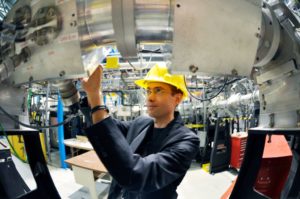Clean Energy Canada | Innovative “Third-Way” Technologies Could Launch Climate Fight Forward
November 26, 2015

To significantly affect climate change, we need to fight carbon pollution by the gigatonne.
To do this, we have multiple simultaneous paths to take. First and foremost, we must prioritize reducing emissions through energy efficiency, renewable energy, and behavioural change. The costs of wind and solar have dropped so dramatically, and the diverse benefits of renewable technologies have become so apparent, that there is no longer any excuse against moving towards a low-carbon economy.
A recent report from Bloomberg New Energy Finance found that onshore wind is fully competitive with gas and coal in much of the world, while the gap continues to close for solar. According to Clean Energy Canada, clean energy generation investment in Canada jumped 88 percent in 2014. In 2013, the rate of job growth in renewables outpaced that of every other sector.
In my country, Australia, 1.4 million households—20 percent of the population—have rooftop solar to mitigate the impacts of high and volatile energy prices, and their return on investment is better than money in the bank.
But will we be able to reduce emissions and ramp up the renewable energy economy fast enough to avoid 2°C of warming? We don’t know, but it is looking increasingly unlikely. There is a good case, given current atmospheric concentrations of greenhouse gasses, that we must also invest in what I call ‘third way’ technologies that remove carbon from the atmosphere, while still relentlessly cutting our greenhouse gas emissions.
This is not geoengineering, which aims to modify the chemical balance of our atmosphere to address climate change. Rather, it is the direct removal of carbon dioxide from the atmosphere. Potential solutions to this challenge range from the familiar, such as wetlands restoration, to the off-beat yet intriguing.
In 2007, after reading my book The Weather Makers, Sir Richard Branson invited me to judge the $25 million Virgin Earth Challenge alongside Al Gore, James E. Hansen, James Lovelock and Sir Crispin Tickell. Teams entering the competition had to demonstrate how they could remove a gigatonne of carbon from the atmosphere, with proven technical and economic feasibility.
A gigatonne sounds like an enormous amount, and it is. In round figures, one gigatonne of carbon removed from the atmosphere is roughly equivalent to one-tenth of the carbon pollution humans emit every year. If we are to stop short of 2°C of warming by 2100, humanity will need to be drawing many gigatonnes of carbon out of the atmosphere annually well before the end of the century.
Back in 2007, the technologies and methods presented were rudimentary. As we draw closer to 2020, and as humanity’s carbon emissions levels continue to grow, some of the technologies encouraged by Branson’s initiative have developed to look more and more like indispensable tools for our survival. Promising technologies include biochar, bio-energy, direct air capture, and carbon capture and storage under the deep ocean, where over time, the pressure turns CO2 gas into stable hydrates.
Canadian company Carbon Engineering is one of 10,000 contest candidates, and is now leading one of the 11 finalist streams. They have designed a system to capture CO2 from the atmosphere to make low-carbon fuels, and expect to develop a pilot plant by 2017.
Despite the promise of these exciting innovations, their impact remains speculative. Many may not live up to expectations, with scalability and cost remaining critical barriers. Technology-based solutions should therefore be viewed as a long-term investment to allow for future prosperity, and to mitigate against the most severe effects of climate change.
What is absolutely clear is that technology investment should not be viewed as an alternative to dramatic and immediate reductions to carbon pollution.
Technology investment should not be viewed as an alternative to dramatic and immediate reductions to carbon pollution.
We must reduce emissions, and we have an opportunity through the upcoming climate negotiations in Paris to re-commit to this path. We must invest heavily in clean technology, with numerous studies showing that 100% renewable energy is possible and will strengthen and diversify local economies. And in parallel, we must consider and support technology innovations that could contribute to holding back a warming climate to within a range in which human civilization can thrive.
In my latest book, Atmosphere of Hope, I argue that humanity must begin working on and investing in third-way technologies now, so that they will be mature enough if, and when, we need them. We already have many of the tools required to avoid a climate catastrophe. Many others are under development, and many more are possible if we make conscious decisions to act now.
An alternate future is laid out before us, and we can truly achieve it. This future belongs to us, and the choices we make as consumers and investors. It belongs to the decisions we make as citizens, and the decisions we tolerate being made in our name.
May we choose wisely, together.
Tim Flannery is the author of The Weather Makers and Atmosphere of Hope. He is the recipient of Simon Fraser University’s 2015/16 Jack P. Blaney Award for Dialogue.